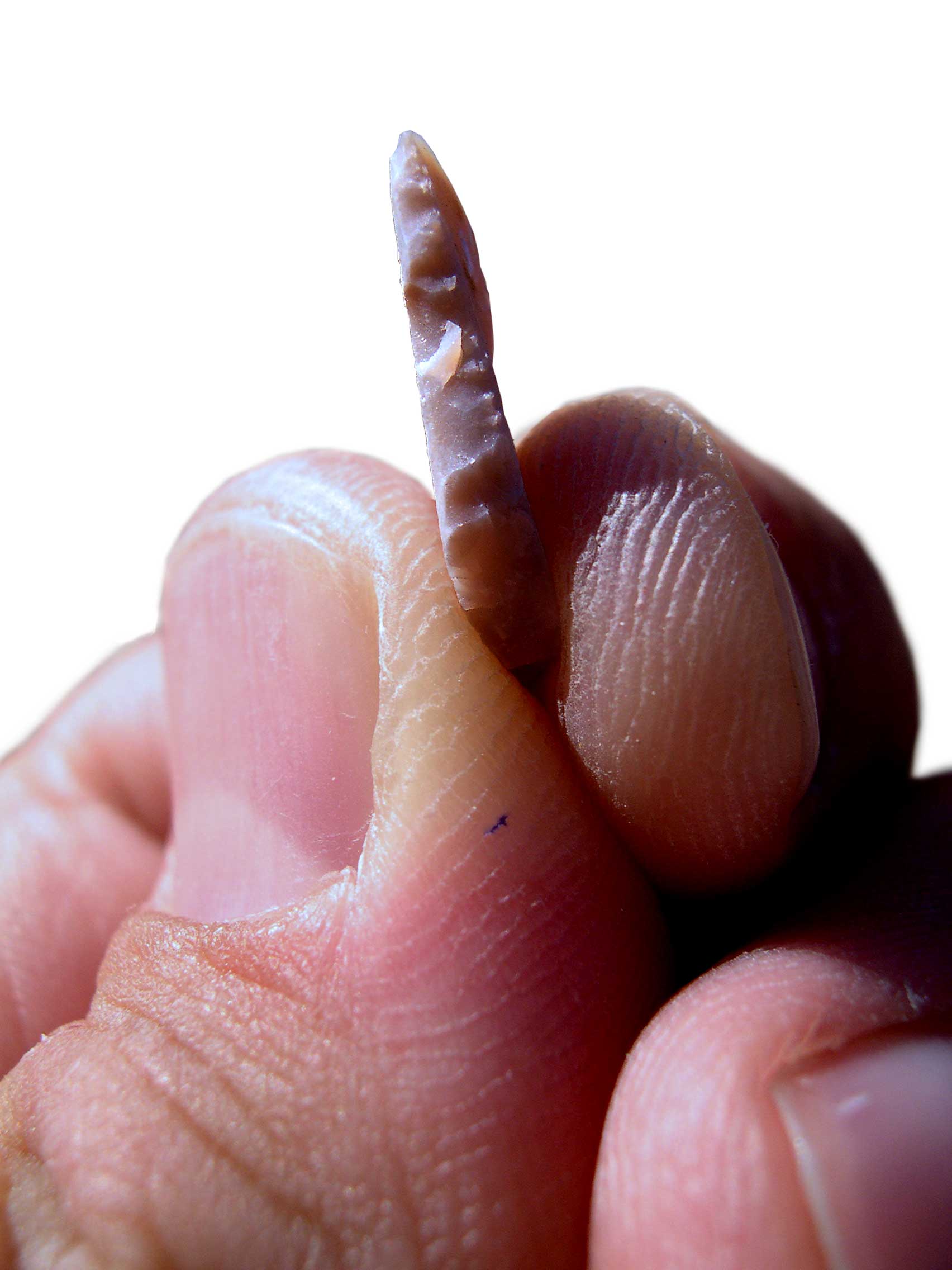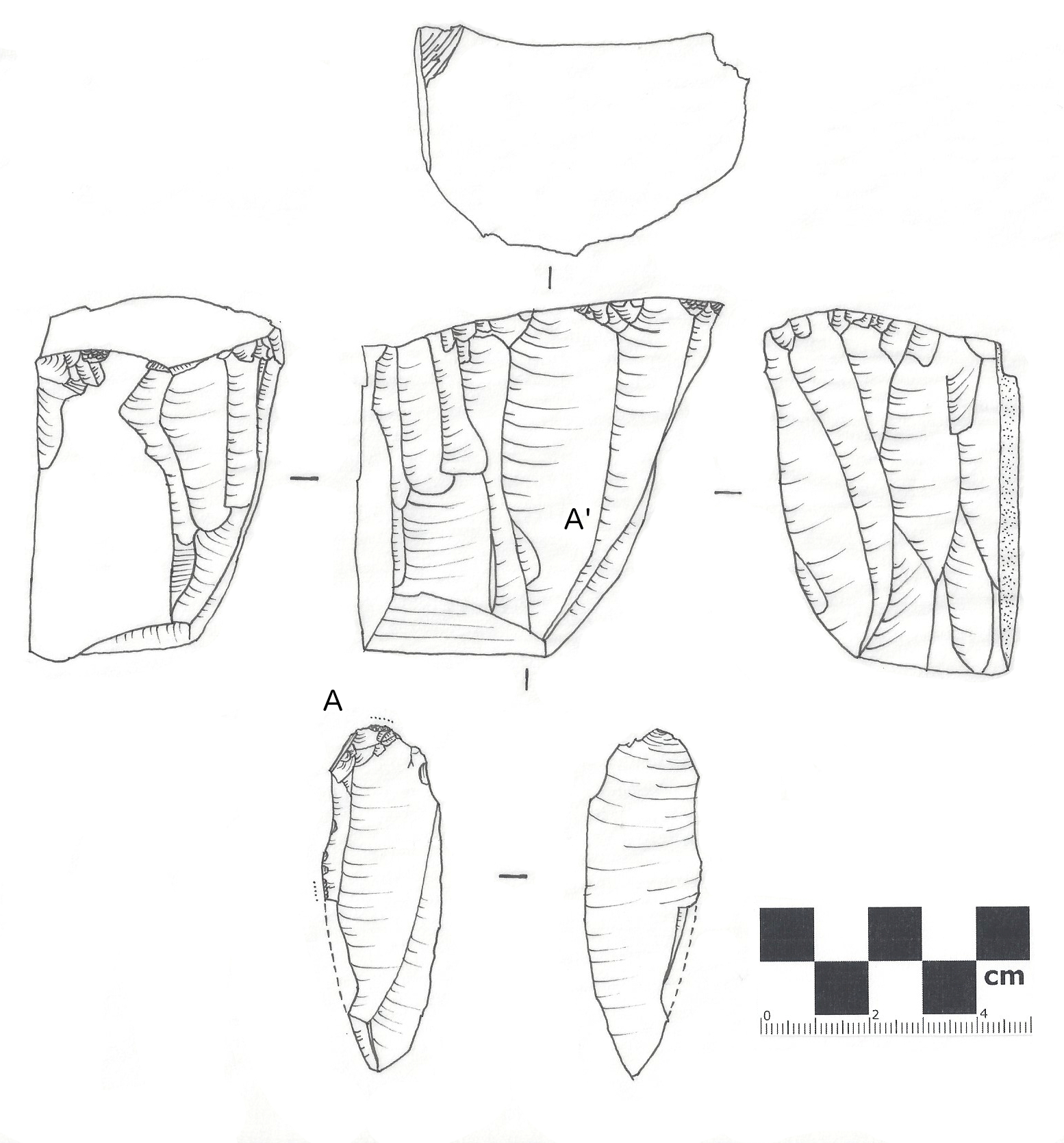|
Microburin Technique
The microburin technique is a special procedure for cutting up lithic blades which yields fragments that can be used in the manufacture of utensils. The usable fragments are basically geometric microliths. This technique has been recorded through the Old World, from at least the Mesolithic. It has also been recorded from the later phases of the Upper Paleolithic, as triangular and trapeze shaped microliths have been found from the end of the French Magdalenian although they are very rare. The microburin blow technique has not been found, at present, in the New World. The technique consists of taking a blade (a flake can also be used) and placing its upper end against a support with a sharp edge (as occurs in the use of an anvil). A notch is then made and enlarged using light blows or by pressing the edge of the piece against the angled edge of the support. The notch is enlarged until the lithic blade snaps with a gentle but positive action ( flection). If the technique is carried ... [...More Info...] [...Related Items...] OR: [Wikipedia] [Google] [Baidu] |
Anvil
An anvil is a metalworking tool consisting of a large block of metal (usually forged or cast steel), with a flattened top surface, upon which another object is struck (or "worked"). Anvils are as massive as practical, because the higher their inertia, the more efficiently they cause the energy of striking tools to be transferred to the work piece. In most cases the anvil is used as a forging tool. Before the advent of modern welding technology, it was the primary tool of metal workers. The great majority of modern anvils are made of cast steel that has been heat treated by either flame or electric induction. Inexpensive anvils have been made of cast iron and low quality steel, but are considered unsuitable for serious use as they deform and lack rebound when struck. Structure The primary work surface of the anvil is known as the face. It is generally made of hardened steel and should be flat and smooth with rounded edges for most work. Any marks on the fac ... [...More Info...] [...Related Items...] OR: [Wikipedia] [Google] [Baidu] |
Tardenoisian
The Tardenoisian (or Beuronian) is an archaeological culture of the Mesolithic/Epipaleolithic period from northern France and Belgium. Similar cultures are known further east in central Europe, parts of Britain. and west across Spain. It is named after the type site at Fère-en-Tardenois in the Tardenois region in France, where E. Taté first discovered its characteristic artifacts in 1885. Characteristic artifacts differ from earlier industries by the presence of geometric microliths, microburin, scalene triangles, trapezoids and chisel-ended arrowheads and small flint blades made by the pressure-technique. The term is also used for several microlithic industries and sites in northern Italy and Eastern Europe and to distinguish the northern French Tardenoisian sites from the Sauveterrian industry in southern France. The Tardenoisian followed the Ahrensburgian, with which it was paralleled, and lasted from about 9.000 BC until 6.000 in the Neolithic The Neolithic period ... [...More Info...] [...Related Items...] OR: [Wikipedia] [Google] [Baidu] |
Lunate
Lunate is a crescent or moon-shaped microlith. In the specialized terminology of lithic reduction, a lunate flake is a small, crescent-shaped flake removed from a stone tool during the process of pressure flaking. In the Natufian period, a lunate was a small crescent-shaped stone tool that was sometimes used to harvest grasses. In archaeology a lunate is a small stone artifact, that has a sharpened straight edge and a blunt crescent shaped back. The word originates from the Latin word lunatus which means to bend like a crescent, and from luna meaning moon in Latin. A lunate object can be typically used as a decorative piece or as a stone tool. Israeli lunate In the earlier findings of Epipaleolithic lunate in the Natufian, Harifian, and Negev Kebaran periods in Israel they were roughly 10–40 mm long and were formed on small blades or bladelets. While the later findings Natufian and Harifian range of lengths varied then from 9–17 mm. In the later period the ... [...More Info...] [...Related Items...] OR: [Wikipedia] [Google] [Baidu] |
Trapeze
A trapeze is a short horizontal bar hung by ropes or metal straps from a ceiling support. It is an aerial apparatus commonly found in circus performances. Trapeze acts may be static, spinning (rigged from a single point), swinging or flying, and may be performed solo, double, triple or as a group act. The name of the apparatus reflects the trapezoid shape made by the horizontal bar, ropes and ceiling support. History The art of trapeze performance is reported to have been developed by Jules Léotard, a young French acrobat and aerialist, in Toulouse Toulouse ( , ; oc, Tolosa ) is the Prefectures in France, prefecture of the Departments of France, French department of Haute-Garonne and of the larger Regions of France, region of Occitania (administrative region), Occitania. The city is on t ... in the mid-1800s. He is said to have used his father's swimming pool to practice. However, the name "trapeze" can be found in books dating as far back as twenty years earlier, bef ... [...More Info...] [...Related Items...] OR: [Wikipedia] [Google] [Baidu] |
Geometric Microliths
A microlith is a small stone tool usually made of flint or chert and typically a centimetre or so in length and half a centimetre wide. They were made by humans from around 35,000 to 3,000 years ago, across Europe, Africa, Asia and Australia. The microliths were used in spear points and arrowheads. Microliths are produced from either a small blade ( microblade) or a larger blade-like piece of flint by abrupt or truncated retouching, which leaves a very typical piece of waste, called a microburin. The microliths themselves are sufficiently worked so as to be distinguishable from workshop waste or accidents. Two families of microliths are usually defined: laminar and geometric. An assemblage of microliths can be used to date an archeological site. Laminar microliths are slightly larger, and are associated with the end of the Upper Paleolithic and the beginning of the Epipaleolithic era; geometric microliths are characteristic of the Mesolithic and the Neolithic. Geometric microl ... [...More Info...] [...Related Items...] OR: [Wikipedia] [Google] [Baidu] |
Retouch (lithics)
Retouch is the act of producing scars on a stone flake after the ventral surface has been created. It can be done to the edge of an implement in order to make it into a functional tool, or to reshape a used tool. Retouch can be a strategy to reuse an existing lithic artifact and enable people to transform one tool into another tool. Depending on the form of classification that one uses, it may be argued that retouch can also be conducted on a core-tool, if such a category exists, such as a hand-axe. Retouch may simply consist of roughly trimming an edge by striking with a hammerstone, or on smaller, finer flake or blade tools it is sometimes carried out by pressure flaking In archaeology, in particular of the Stone Age, lithic reduction is the process of fashioning stones or rocks from their natural state into tools or weapons by removing some parts. It has been intensely studied and many archaeological industri .... Other forms of retouch may include burination, which is re ... [...More Info...] [...Related Items...] OR: [Wikipedia] [Google] [Baidu] |
Microburin
A microburin is a characteristic waste product from manufacture of lithic tools — sometimes confused with an authentic burin — which is characteristic of the Mesolithic, but which has been recorded from the end of the Upper Paleolithic until the Chalcolithic. This type of lithic artifact was first named by Henri Breuil who defined it as "a type of angular, smooth, with a terminal retouch in the form of a small notch". Breuil initially thought that the microburins had a functional use as a type of microlithic burin. However, he later came to realize that the manufacturing technique was different from that of the burin and that they could be waste products from the manufacture of microliths, but they may have occasionally been reused for a useful purpose, which is expected for parsimonious lithic resource exploitation A microburin is a fragment of a lithic flake, or more precisely, of a lithic blade, that shows on its upper face the beginnings of a notch terminating in an obliqu ... [...More Info...] [...Related Items...] OR: [Wikipedia] [Google] [Baidu] |
Lithic Flake
In archaeology, a lithic flake is a "portion of rock removed from an objective piece by percussion or pressure,"Andrefsky, W. (2005) ''Lithics: Macroscopic Approaches to Analysis''. 2d Ed. Cambridge, Cambridge University Press and may also be referred to as simply a ''flake'', or collectively as debitage. The objective piece, or the rock being reduced by the removal of flakes, is known as a core.Andrefsky, W. (2005) ''Lithics: Macroscopic Approaches to Analysis''. 2d Ed. Cambridge, Cambridge University Press Once the proper tool stone has been selected, a percussor or pressure flaker (e.g., an antler tine) is used to direct a sharp blow, or apply sufficient force, respectively, to the surface of the stone, often on the edge of the piece. The energy of this blow propagates through the material, often ( but not always) producing a Hertzian cone of force which causes the rock to fracture in a controllable fashion. Since cores are often struck on an edge with a suitable angle (<90� ... [...More Info...] [...Related Items...] OR: [Wikipedia] [Google] [Baidu] |
Lithic Blade
In archaeology, a blade is a type of stone tool created by striking a long narrow flake from a stone core. This process of reducing the stone and producing the blades is called lithic reduction. Archaeologists use this process of flintknapping to analyze blades and observe their technological uses for historical purposes. Blades are defined as being flakes that are at least twice as long as they are wide and that have parallel or subparallel sides and at least two ridges on the dorsal (outer) side. Blade cores appear and are different from regular flaking cores, as each core's conchoidal nature is suited for different types of flaking. Blades are created using stones that have a cryptocrystalline structure and easily be fractured into a smooth piece without fracturing. Blades became the favored technology of the Upper Palaeolithic era, although they are occasionally found in earlier periods. Different techniques are also required for blade creation; a soft punch or hammerstone ... [...More Info...] [...Related Items...] OR: [Wikipedia] [Google] [Baidu] |
New World
The term ''New World'' is often used to mean the majority of Earth's Western Hemisphere, specifically the Americas."America." ''The Oxford Companion to the English Language'' (). McArthur, Tom, ed., 1992. New York: Oxford University Press, p. 33: "[16c: from the feminine of ''Americus'', the Latinized first name of the explorer Amerigo Vespucci (1454–1512). The name ''America'' first appeared on a map in 1507 by the German cartographer Martin Waldseemüller, referring to the area now called Brazil]. Since the 16c, a name of the western hemisphere, often in the plural ''Americas'' and more or less synonymous with ''the New World''. Since the 18c, a name of the United States of America. The second sense is now primary in English: ... However, the term is open to uncertainties: ..." The term gained prominence in the early 16th century, during Europe's Age of Discovery, shortly after the Italian explorer Amerigo Vespucci concluded that America (now often called ''th ... [...More Info...] [...Related Items...] OR: [Wikipedia] [Google] [Baidu] |




.gif)
